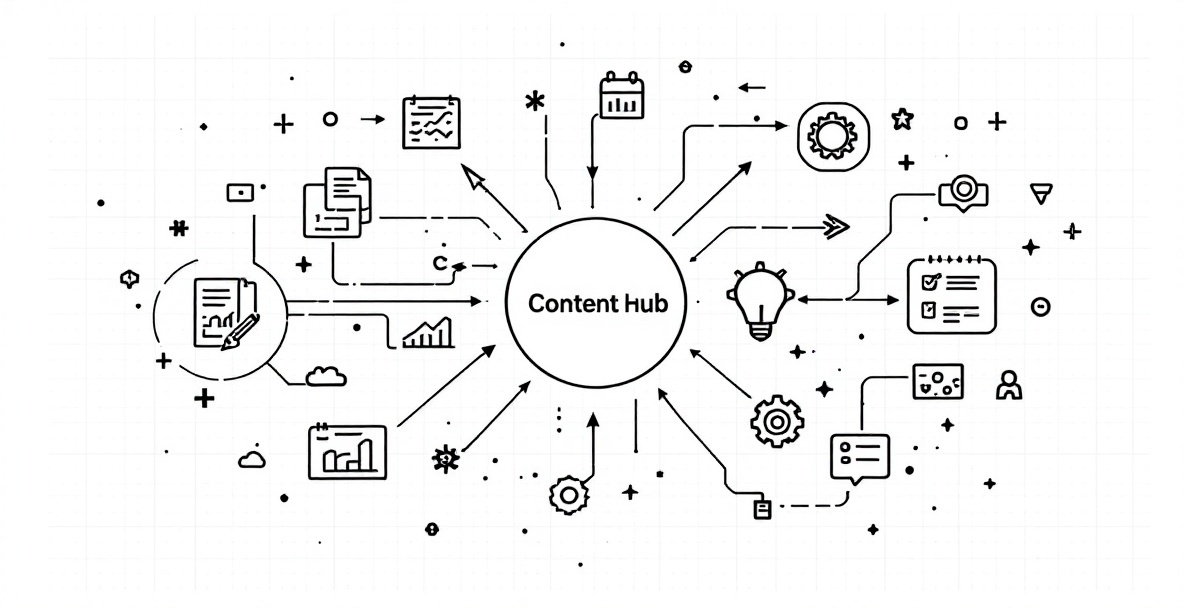In the fast-paced world of content creation, publishers often find themselves juggling multiple tasks, platforms, and deadlines simultaneously. The difference between successful content operations and those that struggle often comes down to one critical factor: workflow efficiency. As content demands continue to grow, implementing the right workflow optimization tools has become not just a convenience but a necessity for sustainable publishing. According to recent industry reports on content workflow challenges, organizations that streamline their content processes see significantly better results. Let's explore how these solutions can transform your content operations and which platforms deliver the best results for different organizational needs.
The Content Chaos: Why Publishers Need Better Workflow Solutions

Content teams today face unprecedented challenges. The pressure to produce high-quality content at scale while maintaining brand consistency across multiple channels has created workflow bottlenecks that traditional processes simply can't handle. Without structured workflows, content operations quickly descend into chaos, with missed deadlines, inconsistent quality, and team burnout becoming the norm rather than the exception.
Common Publishing Workflow Challenges
Most content teams struggle with similar obstacles that hamper productivity and quality. Communication gaps between writers, editors, designers, and stakeholders often lead to misalignment and costly revisions. Version control becomes a nightmare, with team members working on outdated drafts or overwriting each other's contributions. Content approval processes frequently involve convoluted email chains and screenshot feedback, creating confusion about what changes have been requested and implemented.
Perhaps most concerning is the time wasted on repetitive manual tasks that could be automated. When content creators spend hours formatting articles for different platforms, manually scheduling social posts, or copying and pasting content between systems, valuable creative energy gets diverted from what truly matters: producing exceptional content that resonates with audiences.
The ROI of Streamlined Content Workflows
The business case for investing in workflow optimization is compelling. Organizations that implement streamlined content workflows report significant improvements across key performance indicators. Productivity typically increases by 30-50% as teams eliminate redundant tasks and focus on high-value activities. Content quality improves through consistent processes and better collaboration, while time-to-publish decreases dramatically – often by 40% or more.
Beyond these operational benefits, the financial impact is substantial. Reduced overhead costs come from needing fewer resources to manage the same volume of content. Revenue opportunities expand through the ability to publish more frequently and respond faster to market trends. Perhaps most importantly, team satisfaction and retention improve when creative professionals can focus on meaningful work rather than administrative busywork.
Essential Features of Modern Content Workflow Tools

Not all workflow tools deliver equal value. Understanding the must-have features helps organizations select platforms that address their specific pain points while providing room for future growth.
Collaboration Capabilities
Effective content workflows thrive on seamless collaboration. Look for platforms that enable real-time editing and feedback, eliminating the frustration of conflicting versions or lost comments. The ability to assign tasks with clear ownership and deadlines ensures accountability throughout the content lifecycle. Role-based permissions guarantee the right people have appropriate access at each stage of development.
Advanced collaboration features should include contextual commenting directly within content assets, reducing the need to switch between tools. Notification systems keep team members informed of relevant updates without overwhelming them with alerts. The best platforms also facilitate collaboration with external stakeholders like freelancers or clients through secure sharing options that don't require creating new user accounts.
Automation Features
Automation represents the greatest opportunity for workflow efficiency gains. Content calendar management tools automatically track content through production stages and notify team members when action is needed. Template systems ensure consistent formatting and brand compliance while saving hours of manual setup time. Distribution automation pushes finished content to multiple channels simultaneously, formatted appropriately for each platform.
More sophisticated automation capabilities include intelligent workflows that adapt based on content type or performance metrics. For example, high-priority content might follow an expedited approval process, while certain content categories might automatically include specialized review steps. As highlighted in BizTech Magazine's coverage of enterprise workflow efficiencies, the most advanced platforms even incorporate AI-assisted content generation for routine elements like meta descriptions or social media captions.
Analytics and Reporting
Without measurement, optimization is impossible. Comprehensive workflow tools provide visibility into both content performance and operational efficiency. Production analytics track time spent in each workflow stage, identifying bottlenecks that need attention. Team productivity reports help managers balance workloads and recognize top performers. Content effectiveness metrics connect workflow decisions to actual audience engagement.
The most valuable reporting features offer customizable dashboards that highlight the metrics most relevant to different stakeholders. Executives might focus on ROI and output volume, while content creators might prioritize engagement metrics and production velocity. Integration with broader marketing analytics provides context to understand how content workflow impacts larger business objectives.
Top Content Workflow Platforms Compared

The marketplace for content workflow tools has matured significantly, with solutions now available for organizations of every size and budget. Finding the right fit requires evaluating options based on your specific requirements.
Enterprise Solutions
Large organizations with complex publishing needs typically require robust platforms that can handle significant content volume across multiple teams and channels.
Sitecore Content Hub offers comprehensive digital asset management alongside powerful workflow capabilities. Its strength lies in enterprise-grade governance features and the ability to manage content across global teams. However, the implementation process can be lengthy, and the learning curve is steep for new users.
Adobe Experience Manager excels at omnichannel content management with sophisticated personalization options. Its integration with other Adobe Creative Cloud products makes it attractive for organizations already in the Adobe ecosystem. The downside is its significant cost and resource requirements for proper implementation.
Contentful approaches enterprise publishing with a headless CMS architecture that separates content creation from presentation, making it ideal for organizations publishing across diverse platforms. Its API-first approach supports extensive customization, though technical expertise is required to maximize its capabilities.
Mid-Market Tools
Mid-sized organizations need solutions that balance sophisticated features with reasonable implementation requirements and costs.
Notion has gained popularity for its flexible workspace approach that combines document management, task tracking, and collaboration. Its intuitive interface reduces training time, though some users find it lacks the structured workflows needed for complex publishing operations.
Asana focuses on project management with strong task visualization and timeline features. While not specifically designed for content workflows, its customizable project templates make it adaptable to content operations. Some teams find its notification system overwhelming without careful configuration.
SeoFlow stands out by combining AI-powered content generation with comprehensive workflow management. It's uniquely positioned to handle the entire content lifecycle from topic research through multi-platform publishing. Its integration with popular publishing platforms like WordPress and Ghost eliminates manual transfer steps that plague many workflows. The platform's advanced AI understands brand voice and produces content tailored to specific requirements, while built-in SEO optimization ensures content performs well in search results.
Budget-Friendly Options
Smaller teams and startups need affordable solutions that still deliver significant workflow improvements without complex setups.
Trello provides a simple, visual approach to workflow management using boards, lists, and cards. Its simplicity makes it accessible to teams with limited technical expertise, though more complex publishing processes may outgrow its capabilities.
ClickUp offers impressive functionality at a competitive price point, with customizable workflows and robust document collaboration. Some users report that its extensive feature set can feel overwhelming initially, requiring intentional onboarding.
Airtable combines the accessibility of spreadsheets with database capabilities and project management features. This flexibility allows teams to create custom workflow solutions without coding, though advanced users may encounter limitations compared to purpose-built publishing platforms.
Implementation Strategies for Success

Selecting the right tool is only half the battle. Successful implementation requires thoughtful planning and change management to ensure adoption and maximize return on investment.
Assessing Your Workflow Needs
Before evaluating specific tools, document your current processes to identify pain points and opportunities. Involve team members from different roles to gather diverse perspectives on workflow challenges. Consider not just current needs but future scalability as your content operations grow.
Map your ideal workflow first, then look for tools that support it rather than forcing your process to fit a particular platform's limitations. Prioritize solving your most critical bottlenecks, recognizing that even incremental improvements can deliver significant results. As outlined in expert best practices for content creation workflows, implementing a flexible system that can evolve with your organization's needs is crucial for long-term success. Whenever possible, look for platforms that offer trial periods or demo environments where you can test workflows with actual content before committing.
Training and Adoption Tips
Even the best workflow tool will fail without proper adoption. Start with a core team of champions who can test the platform and help refine implementation before full rollout. Develop clear, role-specific training materials that focus on how the tool solves existing pain points rather than just listing features.
Consider a phased implementation approach that introduces functionality gradually to avoid overwhelming users. Create opportunities for regular feedback and make visible improvements based on user suggestions to demonstrate responsiveness. Establish clear metrics for adoption and usage to identify where additional support may be needed.
Remember that workflow changes often reveal underlying process issues that existed before implementation. Be prepared to refine both your tools and your processes iteratively as you learn what works best for your specific team and content needs.
Making the Right Choice: Next Steps
With so many options available, making a final decision can feel daunting. A structured approach can help clarify priorities and narrow your choices.
Decision Framework
Start by categorizing your requirements into "must-have" versus "nice-to-have" features. Consider technical factors like integration capabilities with your existing tech stack and security requirements. Evaluate the total cost of ownership, including not just subscription fees but implementation, training, and ongoing management costs.
Don't underestimate the importance of user experience and interface design. Tools that feel intuitive to your team will see higher adoption rates regardless of feature depth. Check reviews from organizations similar to yours to understand how the platform performs in comparable environments.
Most importantly, align your selection with your strategic content goals. A tool that excels at rapid production of high-volume content may not be ideal if your focus is on creating fewer, more complex pieces requiring extensive collaboration.
Implementation Checklist
Once you've selected a tool, create a detailed implementation plan that includes:
- Technical setup requirements and timeline
- Data migration strategy if moving from existing systems
- User account structure and permission settings
- Customization of workflows and templates to match your processes
- Integration configuration with other platforms in your stack
- Training schedule and materials development
- Success metrics and evaluation timeline
- Ongoing support and feedback mechanisms
At SeoFlow, we've helped numerous organizations transform their content operations through optimized workflows. Our experience has shown that successful implementations always begin with clear objectives and involve stakeholders throughout the process. The most effective transitions occur when teams understand how the new system will make their work easier rather than adding complexity.
Content workflow optimization represents one of the highest-return investments content teams can make. By eliminating inefficiencies and enabling creators to focus on quality rather than administrative tasks, the right workflow tool can transform both content output and team experience.
Ready to revolutionize your content workflow? Try SeoFlow today to experience how our AI-powered platform can cut your content production time in half while improving quality and consistency. Our team is ready to help you assess your current workflow challenges and design a customized solution that delivers immediate results.




